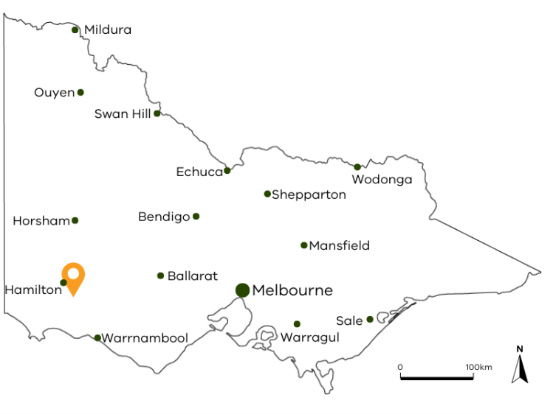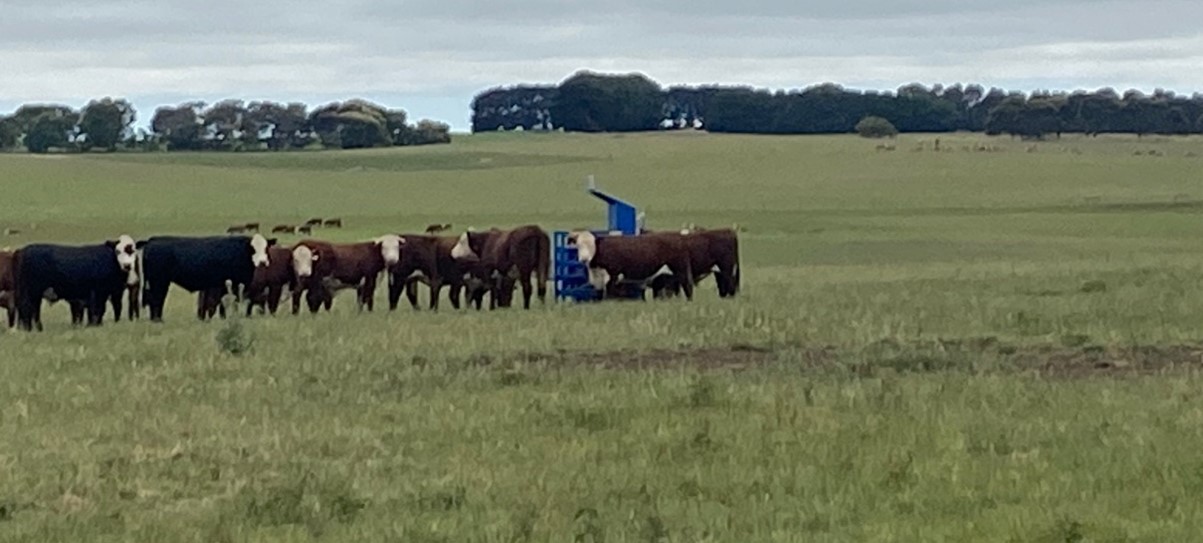A measured approach to reducing carbon emissions

About Banemore
- Jonathan and Jo Jenkin run a beef and sheep farming enterprise in the western district at Yatchaw, near Hamilton in south-west Victoria.
- Banemore spans 1,000 ha and for beef in 2021 had a first-cross breeding system calving 365 calves in August/September and being turned off 8–10 months later.
- The sheep enterprise is a self-replacing flock, with 2,900 composite ewes lambing in winter and spring, turning off lambs in summer, autumn and winter.
- Across the farm there are approximately 96 ha of woody vegetation covering 10% of the property. This constitutes mixed native species in protected and regenerating remnant vegetation areas, shelterbelt and forestry plantings over the last 17 years. It provides habitat to support native birds and animals, shelter for stock and an opportunity to capture carbon.
- Of the total area of woody vegetation, there are 61 ha of blue gums, of which 47 ha have been harvested and allowed to regrow through coppicing.
- The Jenkins see the importance in achieving both ongoing livestock production efficiency and building woody vegetation reserves for ecological, stock protection and carbon sequestration purposes. Agroforestry has also been part of the farm system.
- Their aspiration is to move towards carbon neutrality on the farm.
Farming and carbon emissions
In Australia, there’s a big focus on how farms manage greenhouse gas (GHG) emissions and store carbon. Efficient production to manage and reduce emissions is becoming increasingly important.
Agriculture Victoria’s On-Farm Emissions Action Plan Pilot is working with Victorian farmers to know, understand, and act on their farm GHG emissions.
At Banemore, making production more efficient is very important. They achieve this not only through breeding and selection but also by using the best land management practices to ensure sustainability and biodiversity on the farm.
Jonathan and Jo joined the Agriculture Victoria Pilot program to work towards carbon neutrality. This program helps them find ways to reduce emissions specific to their farm.
We both have had discussions with family and friends about the impact of red meat production on climate. The project [Pilot] presented a great opportunity to put some evidence behind what is happening on our property and how we can influence it.
Banemore is located in the Glenelg–Hopkins region of south-west Victoria. The farm has gently rolling hills, flood plains and peat swamps. It also has rocky areas from its volcanic past. The soils are dominantly brown duplex and the average annual rainfall is 704 mm. The family has owned the farm since the 1980s, when there were few trees.
Jonathan said, ‘It was a life goal of the family to have over 10% of the farm covered by trees, where revegetation of the property continues each year with the development of wildlife corridors and fencing off of creeks and drains’.
In the early 2000s, they planted about 61 hectares of blue gums as shelter belts. In 2019, they harvested 47 hectares of these trees and allowed them to regrow (coppice), using the area for co-grazing livestock.
Currently, the pasture mainly consists of perennial ryegrass, sub-clover and strawberry clover. About 15% of the pasture is phalaris-based, and 10% is native pasture in the rocky areas. They regularly apply superphosphate to maintain pasture productivity and practice rotational grazing, with set stocking rates during lambing and calving times.
Around 4% of the area is used for summer forage crops as part of their pasture improvement program and they are also reducing urea use. Most paddocks get water from solar-powered pumps to troughs, and dams are fenced and planted with vegetation.
The farm has a 34-hectare wildlife corridor with protected vegetation. The Jenkins family plans to rehabilitate 15 hectares of wetlands that have been mapped. They monitor improvements through annual benchmarking with the Livestock Monitor Farm Project and have completed a farm emissions audit through the CN30 program of Meat & Livestock Australia.
Know Your Number
‘Know Your Number’ is a way to measure the greenhouse gas (GHG) emissions from a farm using a special tool like the Greenhouse Accounting Framework (GAF) calculator.
This number is the total amount of carbon dioxide equivalents (CO2-e) produced by the farm each year. It includes 3 types of emissions, called scopes:
- Scope 1: Emissions from livestock (like enteric methane from sheep and cows), nitrous oxide from nitrogen fertilizer application, urine and dung, and carbon dioxide from fossil fuel use.
- Scope 2: Emissions resulting from the electricity the farm uses.
- Scope 3: Emissions created in manufacturing products the farm buys (embedded).
Farms can also capture and store carbon in trees and soils, a process known as carbon sequestration. This captured carbon can be used to balance against their emissions, which is called ‘insetting’.
For Banemore, the emissions analysis for 2021–22 showed that 90% of the farm’s emissions came from enteric methane produced by livestock. Beef cattle contributed 41% and sheep 49% of this methane. Nitrous oxide emissions from fertilisers, urine, dung, leaching, run-off and atmospheric deposition made up about 9% of the emissions.
The farm’s 96 hectares of trees helped inset 5% of the emissions, capturing an estimated 149 tonnes of CO2-e per year. In 2021, the annual carbon sequestration rate was estimated to be between 0.2 and 5.0 t CO2-e per hectare. Higher rates were associated with younger mixed-species plantings and regenerating vegetation, while lower rates were in the recently coppiced blue gums. These estimates are conservative and actual sequestration might be higher.
Emissions intensity
Emissions intensity measures the emissions (as CO2-e) per unit of product, reflecting production efficiency. It helps compare farms of different sizes.
For Banemore, the emissions intensity in 2021–22 for red meat production was within the industry average. For beef, net emissions were 16.2 kg CO2-e per kilogram of liveweight (LWT) without tree sequestration. This compares to a statewide quartile 1 to 3 range of 12 to 24 kg CO2-e per kg LWT. For lamb, the emissions intensity was 9.7 kg CO2-e per kg LWT, with the statewide range being 7 to 9 kg CO2-e per kg LWT.
Including tree sequestration, the emissions intensities dropped to 15.5 kg CO2-e for beef and 9.1 kg CO2-e per kg LWT for sheep.
Participating in the pilot program gave the Jenkin’s new insights into their farm’s emissions profile: ‘Understanding that we were a long way from carbon neutral on our property despite having over 30 ha of remnant vegetation and extensive shelter belts and blue gum plantations. Once you deep dive into what influences your emissions from livestock, you discover that improving your emissions story is very closely aligned to improving your production system, livestock wellbeing and profitability’, said Jonathan.
Acting to reduce emissions
The Jenkins prioritise improving livestock production through genetic selection, breeding and management to enhance production and reproductive efficiency. They already use many best practices, including those from Lifetime Ewe Management. Jonathan analysed their farm data and found that selling cattle at 14 to 16 months as yearlings, instead of at 9 to 10 months as weaners, improved their emissions intensity.
Jonathan said, ‘Their perceived impact of a longer time to turnoff would be higher emissions intensity, but with the spring calving system, once cattle reached 12 months in the following spring, their growth rate increased significantly, where yearling cattle had a higher average growth rate than the weaner cattle. The result is that the emissions per kilogram (meat) sold were lower on long-fed cattle’.
Jonathan did another GAF analysis for the 2023–24 financial year to see how changes in stock management and seasons affected farm emissions. He found that even though total net emissions went up by approximately 10% compared to the 2021–22 assessment, the emissions intensity per kilogram of livestock weight went down. For beef, net emissions were now 14.0 kg CO2-e per kilogram LWT without tree sequestration, which was a 14% drop compared to 2021–22. For sheep, the emissions intensity was 6.0 kg CO2-e per kilogram LWT, a 38% reduction.
It was found in the beef enterprise that these differences were driven by improvements in growth rate and turnoff weight. In the sheep enterprise increased lamb growth rate, a younger turnoff age and reduced carryover lambs and replacement ewes resulted in the lower emissions intensity.
Jonathan said, ‘This shows that every year is different, and we need to ideally do GAF assessment over several years to understand the impact of seasons and management. We’ve substantially reduced our emissions intensity by changing how we manage our stock’.
The Jenkins consider the challenging aspect of the yearling system is optimising the feed and nutrition through the winter months, when ongoing monitoring of stock condition is crucial. A pilot action plan grant supports their goals and the installation of an Optiweigh system helps measure liveweight gain in the paddock, allowing for better management of nutrition and health.
The future
The Optiweigh system helps monitor real-time weights and optimise growth rates without mustering. This allows specific management of different livestock classes (such as young bulls, Polled Hereford heifers, Black Baldy steers and Black Baldy heifers) and optimises herd makeup. In the long term, the Jenkins aim to improve their genetic base around selection for better emissions performance.

Finally, regarding the pilot program and the future Jonathan said, ‘Do a GAF [Greenhouse Accounting Framework] assessment to get started. Be curious and don’t take it personally if it isn’t what you expected. Know your baseline emissions but consider it in the context of the stage of your business and the season/year. Also consider that this will be a market-based issue as well as a global climate issue’.
This case study is part of a series outlining practical actions Victorian farmers are implementing on farm as part of Agriculture Victoria’s On-Farm Emissions Action Plan Pilot program.
Acknowledgements
Author – James Nuttall, Agriculture Victoria, 2024
For further information on the project email actionplanpilot@agriculture.vic.gov.au
The On-Farm Emissions Action Plan Pilot is part of the Victorian Government’s Agriculture Sector Emissions Reduction Pledge to provide practical information, tools and services to support farmers to understand and reduce emissions. The Pilot will work with up to 250 farm businesses across the state to estimate their on-farm emissions profile and identify potential actions to manage and reduce emissions while maintaining productivity and profitability.